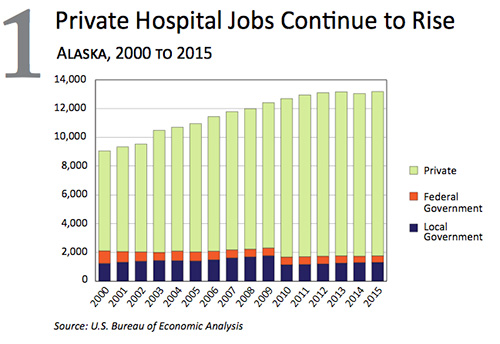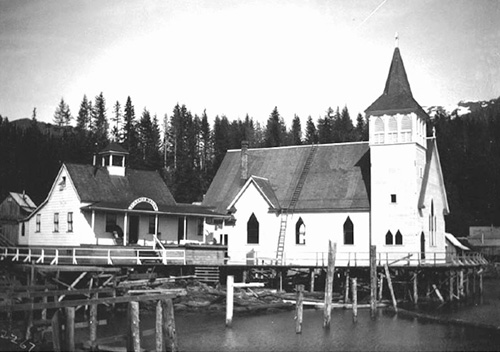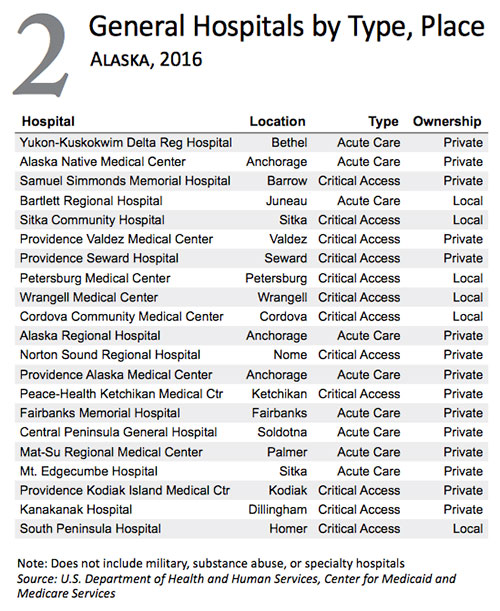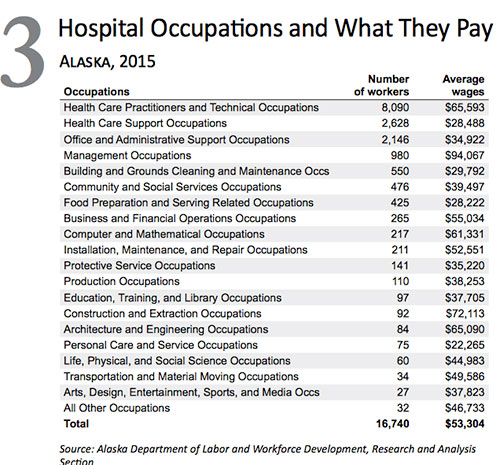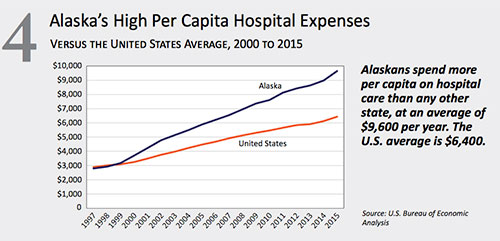
Alaska's Hospitals: Employment has grown steadily to serve a bigger, older populationBy MALI ABRAHAMSON
December 01, 2016
The state has fewer hospital jobs per capita than the national average, and Alaska’s size and the remoteness of many populated areas complicates access. However, stronger- than-average growth over the past decade has brought the state’s hospital jobs up to about 4 percent of total wage and salary employment, close to the nation’s 4.4 percent.
How Alaska’s early hospitals were established Alaska’s hospitals were established in the same pattern as early Euro-American exploration and settlement. The first American hospital in Alaska opened in Sitka in 1867 at the site of a former Russian hospital that had been operating since around 1820. Although that first hospital was an army post, many of the hospitals that followed were founded by missionaries as they arrived and settled throughout the early 1900s. Religious organizations have long been providers of traditional health care, and they were instru mental in establishing facilities in the frontier towns as they grew. Catholic nuns founded the first hospital in Juneau, and Episcopalians opened a log cabin hospital in Skagway. The health care legacy of churches remains strong, with two of the larger hospitals in Alaska, Providence in Anchorage and Peace-Health in Ketchikan, owned by religious organizations. The U.S. Bureau of Education was the other major force behind establishing Alaska’s hospitals alongside the assorted social services it delivered in the territorial days. The agency built hospitals in Juneau, Unalaska, Akiak, Noorvik, and Tanana. That role shifted to the Bureau of Indian Affairs in 1931, which continues to provide care at federally owned hospitals and through transfers and joint ventures with Alaska Native organizations.
St. John’s Hospital in Ketchikan was part of St. John’s Episcopal Church, on its right. This photo was taken in 1904 by John Nathan Cobb.
How hospitals are categorized The U.S. Bureau of Labor Statistics and the U.S. Census define hospitals as facilities that provide inpatient medical, diagnostic, and treatment services that include Hospitals are divided into general medical and surgical hospitals, psychiatric and substance abuse hospitals, and specialty hospitals. Alaska has one psychiatric and substance abuse hos-pital and one specialty hospital, and the U.S. Department of Health and Human Services identifies 21 general hospitals, including religious and tribal organizations. For the purpose of administering Medicare, the department divides general hospitals into two categories: critical access and acute care. Acute care hospitals are what we typically think of as larger city hospitals. Critical access facilities are in rural areas and must provide 24-hour emergency care. They have a limited number of beds and limits on how long a patient can stay, and are far away from other hospitals.
Most employment is in private hospitals The bulk of hospital employment is in the pri-vate sector (11,420 jobs), and those facilitiees are often the largest private employers in rural areas. Alaska also has a small amount of government hospital employment. Six local government- owned hospitals employed 1,316 in 2015, and the federal government employed 3 Hospital Occupations and What They Pay about 450 in the Indian Health Service and at two military facilities: Bassett Hospital on Fort Wainwright in Fairbanks and Joint Base Elmendorf-Richardson near Anchorage. As hospitals have continued to expand, their overall employment has increased by about 3 percent per year since 2000, with the vast majority of the growth in private facilities. Private employment alone increased by 65 percent between 2000 and 2015. Average wages also continued to grow during that period, rising by an average of 1.5 percent per year. Total wages paid to hospital employees more than doubled over that 15-year period, reaching $900 million in 2015. Municipal-run hospital employment has remained mostly flat, and federal hospital employment has been cut in half since 2000, because some of those services have been ceded to tribal corporations over time. Most common jobs are in nursing In 2015, more than 16,740 people worked in Alaska hospitals. The workforce included a veritable army of nurses: more than 4,200 registered nurses and 1,500 nursing assistants. Alaska also had 464 health care managers, 600 therapists, 564 physicians and surgeons, and hundreds of technicians and technologists. To help run these large enterprises, hospitals also employ various managers and administrative, maintenance, and food service workers. These employment numbers don’t fully capture the economic impact of hospitals, which also employ a substantial number of subcontractors. For example, some facilities hire a catering service for the cafeteria or use a separate restaurant franchise. Other specialty or ambulatory health care services may also be housed in and affiliated with a hospital, but may be independently owned.
Mostly women, older, and mobile Hospitals employ far more women than men. About 75 percent of hospital workers were women in 2015, and 80 percent of registered nurses and 85 percent of nursing assistants were female. Women also outnumbered men in management, which is unusual for most industries - but more top hospital executives were male. Hospital workers were also older than most workers. In 2015, they were a median 42.7 years old versus 38 statewide, with managers skewing older and health support workers tending to be younger. Hospitals have a lot of turnover, with about half of hospital employees having worked there for fewer than three years. Much of the movement includes workers such as resident doctors matriculating through their programs. Many working in hospitals also have a range of options because their skills are in high demand. Among those working in a hospital in 2015, 13 percent had been working in hospitals for 15 or more years, and most of them had stayed at the same facility. Alaska's Per Capita Hospital Expenses Alaskans spend more per capita on hospital care than any other state, an average of $9,600 per years. The U.S. average is $6,400.
This article is provided as a public service by the Alaska Department of Labor & Workforce Development's Alaska Trends Magazine. Mali Abrahamson [mali.abrahamson@alaska.gov] is a research analyst with the Department of Labor in Juneau.
Representations of fact and opinions in comments posted are solely those of the individual posters and do not represent the opinions of Sitnews.
|
||
